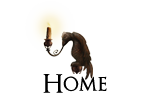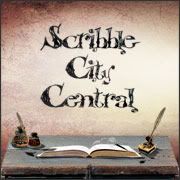I'm so glad Dianne agreed to join in and do a Mythic Friday Interview on Scribble City Central. I've been admiring Dianne's posts on An Awfully Big Blog Adventure for some time now. She always manages to say something interesting--something which makes me think--and the way she uses language is always an object lesson in how to put words together. I was therefore expecting quite a lot from Fish Notes and Star Songs when it arrived. I wasn't disappointed. It is an exquisitely written book--the magical story of Fish, Jonah, Rebecca, Boskind and the unusual but powerful friendships they form--which touched my heart. It also has the best fictional description of a shamanic journey I have ever read. I haven't mentioned this before on the blog, but I spent years of my life doing shamanic training, and delving deep into the myths and cultural practices of many civilisations including my own Celtic one. The shamanic journey Dianne describes (and some may understand it better if described as a journey of the imagination, though it is far more than that) takes place in a cave. For me that was a striking piece of serendipity, since one of my own most powerful shamanic experiences--where I was given a vision of my shamanic animal, as Fish and Jonah are too--also took place in a cave. One culture I have never explored--though I have always wanted to, ever since I read Laurens van der Post's novels A Story like the Wind and A Far-off Place--is that of the San Bushmen. Laurens van der Post is not fashionable nowadays, but these books are two more examples of beautiful writing, and worth seeking out. If nothing else, they have made me a passionate proponent of leaving the indigenous San tribes alone to run their own lives. In these days of worry about carbon footprints, the San Bushmen, like the Native Americans are truly in tune with Mother Earth, and step very lightly upon her. I'm looking forward to having a long chat with Dianne very soon, and getting her to tell me more San stories. What she has said in her answers here have only whetted my appetite. Thank you for visiting, Dianne, and over to you!
1. Do you think that the retelling of myths is important or relevant for the children of today? Why should they care about some “dry old stories” which come from ancient or forgotten cultures they might never even have heard of?
I think telling these stories sparks imagination in a child. Children can be overwhelmed by reality. Myths seem to awaken an inner spirit and a deep archetypal knowledge... a sense of bravery and connection to the earth.
2. What age were you when you came across your first myth or myths? Tell us how you felt then about the myths you first discovered. Did you love them or hate them? Did they scare you, excite you—or were you indifferent? What kind of myths were they? Greek? Norse? Native American? Celtic? Or from another culture entirely? Were they in a book you read? Or did you hear them as oral storytelling from someone else?
My first myths were told to me by my father. In summer when I was about 5 he and I used to lie out on the lawn in the half light and he’d tell me stories about the stars and the moon. I loved the idea that the Milky Way was a path of glowing ashes thrown up into the sky by a young girl from her cooking fire. And that Alderberan (the Red Giant to me) was the husband of seven maidens and when he failed to shoot the three zebras (Orion’s belt) he was watched over for the rest of is life by the Great Lion (Betelgeuse).
I didn’t know it then but these stories were San (bushman) myths. The San people believed in ‘kukummi’. There’s no English equivalent for this word but roughly it means - stories, history, legends of the past. ‘Stories that float from afar’ is how they described ‘kukummi’.
The star myths were so much part of my life that years later when my Ridgeback produced her first litter of eleven puppies they were all registered with star names like Vega, Betelgeuse, Arcturis.
3. Looking back, what is your favourite myth of all time, from any culture? And why would you choose it?
The West African myth of ‘Why the Sun and Moon Live in the Sky’ because it’s a very human. It’s about a husband, Sun, who is overly generous and is beguiled into inviting the Ocean to visit. His wife is a bit disconcerted that she’ll have to put up with all Ocean’s children as well. In the end with Moon scolding her husband, they are left clinging to the rooftop of their home, while Ocean washes in with all her fish and crabs and creatures. Finally with their home completely awash and under water they are forced to go up into the sky. And from that day onwards disenchanted Moon has lived with the stars on the dark side of the sky away from her foolish husband, Sun. Niki Daly’s picturebook of ‘Why the Sun and Moon Live in the Sky’ is wonderful retelling worth looking out for. He has taken an African tale but used Renaissance imagery that works brilliantly.
4. Who is the mythical hero, heroine or being you most dislike, and what made you feel that way about them?
I’m not sure I dislike her but I think Ariadne is not to be trusted. She’s a bit of a minx. (nothing wrong with being a minx!) She was wily enough to know her mother and father’s ways. She knew about her mother’s lover and she knew how the Minotaur had come into existence. She was quite manipulative and coaxed Daedalus (I’m sure by flirting) to do exactly what she wanted… carve dolls for her, build a dancefloor at Knossos and devise a plan to help the handsome Theseus escape the labyrinth so she could run off with him. But I can’t really say I dislike her because she intrigued me so much that I once wrote a short story from her viewpoint.
5. Is there a mythical beast you are particularly fond of? If so, which one?
The Minotaur. I think he deserved better.
6. How have myths had an influence on your writing life, if at all?
A visit to the Valley of the Kings, seeing the Star goddess, Nut, stretched across the ceiling of a tomb in the Valley of the Kings painted in shades of turquoise and cobalt as freshly as if the artist had just put down his brush, inspired me to write my picture book The Starbearer and from there I went on to write the two novels Eye of the Moon and Eye of the Sun set in Ancient Egypt.
And I must thank my father for the star myths I used in Fish Notes and Star Songs. The San people believe that every time a shooting star appears in the sky, a person dies… When a star falls a heart dies. The star’s noise dying away takes our heart with it. I find it quite breath-taking that they believe stars make sounds or songs.
7. If you could choose to be the demigod child of any one mythical god or goddess, which one would it be? Which power would you like to inherit from them—and what would you do with it?
I’d like to be the Goddess of the Moon whether she was Diana, or Artemis, or even Hathor the Egyptian Goddess of the Moon as in my novel Eye of the Moon. The Moon goddess is powerful yet at the same time she has a sense of being a woman. I love the idea that Artemis protected wild places where you could rest and gather strength and that she was very fast. I only discovered I could run fast when I was 40. What a waste. And I like that Diana was also the symbol of the creative insanity that comes with being a poet or artist (read writer for that as well I’m sure.)
More about Dianne:
I grew up on the southern tip of Africa. As a child I loved drawing which is just another way of telling stories. In another life I was an art teacher and a porcelain slipware artist. My first teenage novel was published in 1984. I haven’t stopped writing since – novels, short stories and picture books. My novel Boikie You Better Believe It was short-listed with JM Coetzee and won the M-net Award in South Africa and a short story has appeared in an anthology alongside Doris Lessing, Guy de Maupassant and Roahl Dahl amongst others.
I live in London with my husband and for some of the year on a beach in the southern hemisphere where whales visit. I’m a hopeless on Twitter because I forget, but then I’m hopeless at quite a few things – I can’t ride a bicycle!
Dianne's website is http://www.diannehofmeyr.com/
She blogs at: http://awfullybigblogadventure.blogspot.com/
Friday, 25 June 2010
Mythic Friday Interview: Number 13 - Dianne Hofmeyr
Subscribe to:
Post Comments (Atom)

















9 comments:
Great interview, again - I was wondering when you'd reach someone who could do Southern African mythology here! ;-) The San myths are so rich and colourful - I always wish I knew them better.
Lucy, you need a visit/holiday at !xaus lodgehere
If either of you are further interested, I have an old school friend (an academic) who's doing fascinating research into African mythology with a particular focus on Xhosa mythology - the stories are just amazing.
Simply lovely - what a wonderful story about the Sun, Moon and Ocean - and I'm always intrigued by the different star myths. Did you know very little is known now about the Norse star myths? The horns of the Bull were the jaws of the Wolf, for example, and Corona Borealis may have been known as Freya's Girdle, but the Greek and Roman have almost entirely taken over in Europe. And while I was writing Troll Blood I was researching Mi'kmaq star stories. The Great Bear (or Plough)is still a bear over there, interestingly, but only some of the stars, the quadrangle, while the stars in the 'handle' of the Plough are a line of hunters who follow the bear, and there are various stories about them. The Bear comes out of his lair in springtime and is hunted across the sky during summer and killed in the fall.
Nicky--trying to cover everything (we aim to please here on SCC!). !xaus looks fabulous and I want to go there at once. Am definitely interested in learning more about your school friend's research. Sounds fascinating.
Kath--yes, I too love the Native American star stories, especially those of the Iroquois Iotsitsisen (Starwoman), who came down from the heavens on a beam of light and was gently drawn down to Turtle Island by the wild geese. The Ge highlanders in Brazil and the tribes of the Gran Chacos have other good ones--I like the rather gruesome one about the star's mortal husband, who touches the hearthfire of the seven star sisters (the Pleiades) and is burned to death.
Fascinating stuff Kath. I think we should have a session at Charney when we all lie down on the lawn and tell star myths. Perhaps 'catdownunder' can join us and we can get a taste of some antipodean myths too. It's said myths come from 'savage man'in an attempt to come to terms with natural phenomena in a world without science or measurement. The Greek and Roman myths we know, aren't from a civilised time in their history but from much earlier apparently. Anyway thanks Lucy... am enjoying the series enormously.
Lucy, have a look at this story about the Mamlambo, it'll give you a bit of a taste of what Felicity's looking at. I think, at the moment, she's researching the serpent goddess as she appears across Africa - as Mamawati and as Mamlambo. Fascinating stuff.
"Children can be overwhelmed by reality" - thank goodness' some people recognise that!
Interesting about your shamanic training Lucy. I have a masters in cultural anthropology and did field work for my thesis among the Blackfoot of the Peigan Nation in southern Alberta, Canada.
I love African mythology too and also illustrated the Sun and Moon myth you mention in my picture book 'How Stories came into the World.' I have always wanted to do a picture book of the 'Mantis ' stories but worry they are rather sad and violent for young children - but then what myths aren't?! A very interesting post.
Dianne--definitely need to lie under the stars at C and tell stories! Great idea.
Nicky--that is one scary story. Do go and read it, anyone who hasn't yet. It is all about belief--and we in the West have mostly lost touch with belief in our old tales, and thus taken away their power to affect our daily lives--unlike 'Alice's family in the Mamlambo story. I read Geraldine McCaughrean's 'The Stones are Hatching' the other day, which deals with that very thing. I think the only place you find any sort of traditional belief in the UK now is in some parts of the Highlands and Wales. Care is certainly taken to avoid offending the Good Folk, even if it is done with an embarrassed laugh. I have come across it often--and I don't care to offend them myself, really. I do sometimes wonder if there is a Spirit of the Roads which demands sacrifice....
catdownunder--yes! Indeed!
Jan--wow! I'm not nearly as high powered as that. Though I suppose I did a lot of 'practical'!
Joanna--as I've said before here, it's a question of approach, I think. The sadness and violence in myths can teach valuable lessons if they are presented sensitively. Glad you enjoyed the post.
Post a Comment